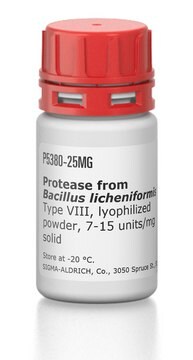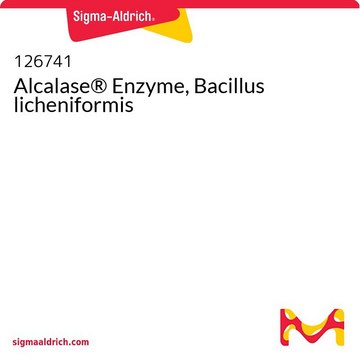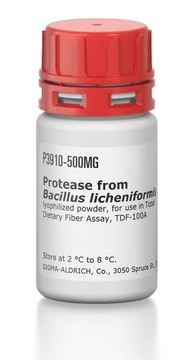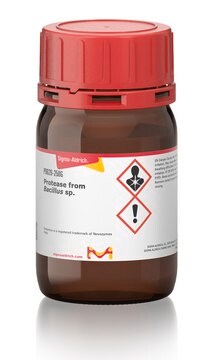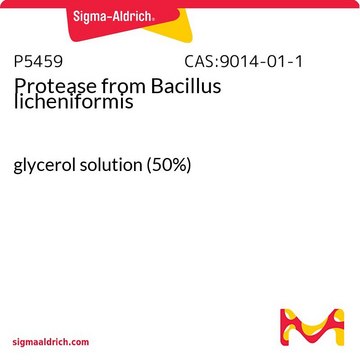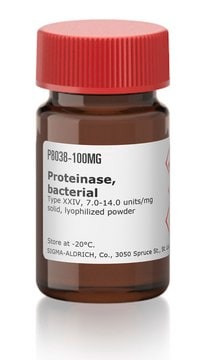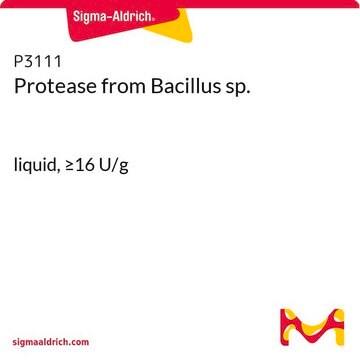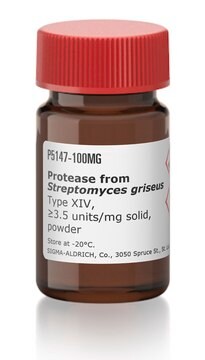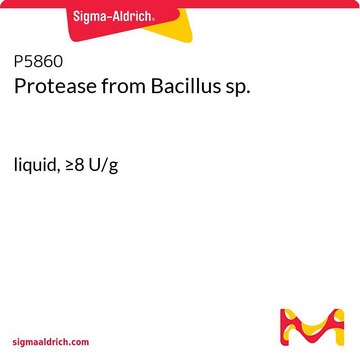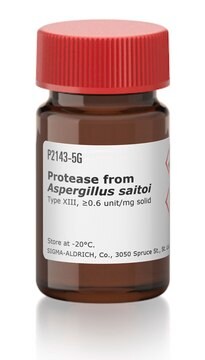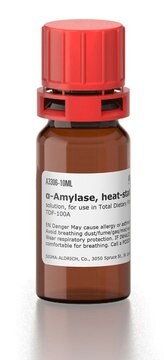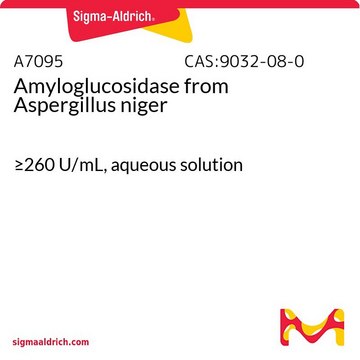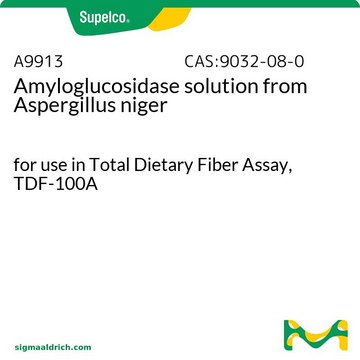Wszystkie zdjęcia(1)
Kluczowe dokumenty
P4860
Protease from Bacillus licheniformis
≥2.4 U/g
Synonim(y):
Alcalase® 2.4L, Proteinase from Bacillus licheniformis, Subtilisin A
Zaloguj sięWyświetlanie cen organizacyjnych i kontraktowych
About This Item
Polecane produkty
Formularz
aqueous solution
aktywność właściwa
≥2.4 U/g
temp. przechowywania
2-8°C
Szukasz podobnych produktów? Odwiedź Przewodnik dotyczący porównywania produktów
Powiązane kategorie
Opis ogólny
Proteolytic enzymes are known to possess catalytic, non-catalytic and ancillary domains. Proteases are broadly classified as endopeptidases and exopeptidases. Functionally they are divided as aspartic, glutamic, cysteine, threonine, serine and metalloproteases.
Zastosowanie
Protease is an enzyme used to break down proteins by hydrolyzing peptide bonds. Protease is used to degrade proteins, to study protease inhibitors and to study thermal inactivation kinetics. Protease is used in nucleic acid isolation procedures in incubations.
The enzyme from Sigma has been used to prepare chicken (leg) bone protein hydrolysates while evaluating ACE inhibitory peptides. It has also been used for the hydrolysis of Chlorella pyrenoidosa protein extracts during a study of their antitumor activities.
Działania biochem./fizjol.
Alcalase is an endo-protease of the serine type. It has a broad substrate specificity and can hydrolyze most peptide bonds within a protein molecule. It is active between pH 6.5 and 8.5 and has an optimum temperature of 60 °C. The enzyme is is used in detergent formulations to remove protein-based stains.
Protease catabolizes proteins by hydrolysis of peptide bonds. Proteases are inactivated by serine active-site inhibitors, such as phenylmethylsulfonyl fluoride (PMSF) and diisopropylfluorophosphate .
Komentarz do analizy
Activity expressed in Anson Units
Informacje prawne
A product of Novozyme Corp.
Alcalase is a registered trademark of Novozymes Corp.
Ta strona może zawierać tekst przetłumaczony maszynowo.
Hasło ostrzegawcze
Danger
Zwroty wskazujące rodzaj zagrożenia
Zwroty wskazujące środki ostrożności
Klasyfikacja zagrożeń
Aquatic Acute 1 - Aquatic Chronic 2 - Eye Dam. 1 - Resp. Sens. 1 - Skin Irrit. 2 - STOT SE 3
Organy docelowe
Respiratory system
Kod klasy składowania
10 - Combustible liquids
Klasa zagrożenia wodnego (WGK)
WGK 2
Środki ochrony indywidualnej
dust mask type N95 (US), Eyeshields, Faceshields, Gloves
Wybierz jedną z najnowszych wersji:
Masz już ten produkt?
Dokumenty związane z niedawno zakupionymi produktami zostały zamieszczone w Bibliotece dokumentów.
Klienci oglądali również te produkty
Catherine Cesa-Luna et al.
PloS one, 15(10), e0240545-e0240545 (2020-10-16)
The bacterial strain, EMM-1, was isolated from the rhizosphere of red maize ("Rojo Criollo") and identified as Pseudomonas protegens EMM-1 based on phylogenetic analysis of 16S rDNA, rpoB, rpoD, and gyrB gene sequences. We uncovered genes involved in the production
Fu-Yuan Cheng et al.
Animal science journal = Nihon chikusan Gakkaiho, 80(1), 91-97 (2010-02-19)
This study aims to identify peptides with angiotensin-I converting enzyme (ACE) inhibitory activity in hydrolysate from chicken leg bone protein hydrolyzed with alcalase for 4 h (A4H). The hydrolysate has demonstrated potent in vitro ACE inhibitory activity, and has been
Xiaoqin Wang et al.
Biotechnology progress, 29(3), 681-687 (2013-04-23)
Chlorella pyrenoidosa is a unicellular green algae and has been a popular foodstuff worldwide. However, no reports on the antitumor peptides from such a microalgae are available in the literature. In this study, using low-temperature high-pressure extraction, enzymatic hydrolysis, ion
Proteases: multifunctional enzymes in life and disease
Lopez-Otin C and Bond JS
Test, 283(45), 30433-30437 (2008)
Keiichi Yokoyama et al.
Applied microbiology and biotechnology, 87(6), 2087-2096 (2010-06-04)
Microbial transglutaminase (MTG) has been used extensively in academic research and the food industries through its cross-linking or posttranslational modification of proteins. Two enzyme engineering approaches were applied to improve MTG activity. One is a novel method of rational mutagenesis
Nasz zespół naukowców ma doświadczenie we wszystkich obszarach badań, w tym w naukach przyrodniczych, materiałoznawstwie, syntezie chemicznej, chromatografii, analityce i wielu innych dziedzinach.
Skontaktuj się z zespołem ds. pomocy technicznej